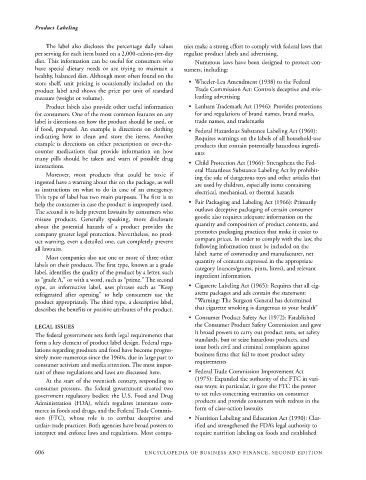Page 629 - Encyclopedia of Business and Finance
P. 629
eobf_P 7/5/06 3:18 PM Page 606
Product Labeling
The label also discloses the percentage daily values nies make a strong effort to comply with federal laws that
per serving for each item based on a 2,000-calorie-per-day regulate product labels and advertising.
diet. This information can be useful for consumers who Numerous laws have been designed to protect con-
have special dietary needs or are trying to maintain a sumers, including:
healthy, balanced diet. Although most often found on the
store shelf, unit pricing is occasionally included on the • Wheeler-Lea Amendment (1938) to the Federal
product label and shows the price per unit of standard Trade Commission Act: Controls deceptive and mis-
measure (weight or volume). leading advertising
Product labels also provide other useful information • Lanham Trademark Act (1946): Provides protections
for consumers. One of the most common features on any for and regulations of brand names, brand marks,
label is directions on how the product should be used, or trade names, and trademarks
if food, prepared. An example is directions on clothing • Federal Hazardous Substance Labeling Act (1960):
indicating how to clean and store the items. Another Requires warnings on the labels of all household-use
example is directions on either prescription or over-the- products that contain potentially hazardous ingredi-
counter medications that provide information on how ents
many pills should be taken and warn of possible drug • Child Protection Act (1966): Strengthens the Fed-
interactions.
eral Hazardous Substance Labeling Act by prohibit-
Moreover, most products that could be toxic if
ing the sale of dangerous toys and other articles that
ingested have a warning about this on the package, as well
are used by children, especially items containing
as instructions on what to do in case of an emergency.
electrical, mechanical, or thermal hazards
This type of label has two main purposes. The first is to
• Fair Packaging and Labeling Act (1966): Primarily
help the consumer in case the product is improperly used.
The second is to help prevent lawsuits by consumers who outlaws deceptive packaging of certain consumer
misuse products. Generally speaking, more disclosure goods; also requires adequate information on the
quantity and composition of product contents, and
about the potential hazards of a product provides the
promotes packaging practices that make it easier to
company greater legal protection. Nevertheless, no prod-
compare prices. In order to comply with the law, the
uct warning, even a detailed one, can completely prevent
all lawsuits. following information must be included on the
label: name of commodity and manufacturer, net
Most companies also use one or more of three other quantity of contents expressed in the appropriate
labels on their products. The first type, known as a grade
category (ounces/grams, pints, liters), and relevant
label, identifies the quality of the product by a letter, such
ingredient information.
as “grade A,” or with a word, such as “prime.” The second
type, an informative label, uses phrases such as “Keep • Cigarette Labeling Act (1965): Requires that all cig-
refrigerated after opening” to help consumers use the arette packages and ads contain the statement:
product appropriately. The third type, a descriptive label, “Warning: The Surgeon General has determined
describes the benefits or positive attributes of the product. that cigarette smoking is dangerous to your health”
• Consumer Product Safety Act (1972): Established
LEGAL ISSUES the Consumer Product Safety Commission and gave
it broad powers to carry out product tests, set safety
The federal government sets forth legal requirements that
standards, ban or seize hazardous products, and
form a key element of product label design. Federal regu-
issue both civil and criminal complaints against
lations regarding products and food have become progres-
sively more numerous since the 1960s, due in large part to business firms that fail to meet product safety
consumer activism and media attention. The most impor- requirements
tant of these regulations and laws are discussed here. • Federal Trade Commission Improvement Act
At the start of the twentieth century, responding to (1975): Expanded the authority of the FTC in vari-
consumer pressure, the federal government created two ous ways; in particular, it gave the FTC the power
to set rules concerning warranties on consumer
government regulatory bodies: the U.S. Food and Drug
Administration (FDA), which regulates interstate com- products and provide consumers with redress in the
merce in foods and drugs, and the Federal Trade Commis- form of class-action lawsuits
sion (FTC), whose role is to combat deceptive and • Nutrition Labeling and Education Act (1990): Clar-
unfair-trade practices. Both agencies have broad powers to ified and strengthened the FDA’s legal authority to
interpret and enforce laws and regulations. Most compa- require nutrition labeling on foods and established
606 ENCYCLOPEDIA OF BUSINESS AND FINANCE, SECOND EDITION

